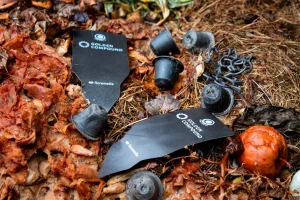Biocomposites, which combine the advantages of technical plastics with natural fibres, are currently trending. They offer sustainable alternatives to purely fossil-based materials. WPC (wood plastic composite) is a particularly well-known example. This composite material, made from wood fibres and plastic, is widely used in decking, furniture, and construction products.
However, a new generation of sustainable materials has emerged: S²PC (Sunflower Plastic Composite). These bioplastics are reinforced with sunflower seed shells, a waste product that offers unique benefits.
1. Comparing raw materials: waste vs. valuable fuel
Wood fibre-reinforced plastics are well-established materials, but their production can conflict with other goals. Wood residues, such as those used in WPC, often originate from by-products of the wood processing industry. However, they are not technically waste products. In times of energy crisis, wood residues are increasingly being used for energy production, for example in the form of pellets for heating. This creates direct competition for the raw material between the building materials industry, the energy supply sector, and the plastics processing industry.
The situation is quite different for sunflower seed shells. They are produced in large quantities automatically during the manufacture of sunflower seeds for human consumption. No one would cultivate a sunflower field solely for the shells. Therefore, the raw material is a genuine by-product that has hardly been utilised to date. There are no significant alternative uses.
Conclusion: There is no competition in the land use system when it comes to sunflower seed shells, which are a valuable raw material and therefore have a clear ecological advantage.
2. Technological advantages in processing
Another advantage of S²PC is that the residual oil content in sunflower seed shells acts as a natural lubricant during processing. This reduces friction in the tool, minimises wear and tear, and often enables shorter cycle times or lower processing temperatures. This saves energy, protects machinery and improves the overall ecological balance.
Conclusion: Not only are S²PC materials more sustainable, they are also more efficient in terms of processing technology.
3. Application areas and material flexibility
Both natural fibres, wood and sunflower seed shells, have their purpose. Combined with a biodegradable polymer such as Bio-PBS, they complement each other's strengths.
- For food-sector applications such as biodegradable coffee capsules (HOMEcap®), wood fibre that has been specially cleaned and approved for food use is required. In these cases, wood fibre remains the material of choice.
- Sunflower seed shells are an excellent alternative for plant pots, packaging, technical components and consumer goods. The residual materials used can even be biodegraded after use if a degradable polymer is used.
Conclusion: Wood fibres are ideal for food-contact products, while sunflower seed shells are more versatile for other applications.
4. Sustainability starts with the raw materials.
When developing sustainable materials, it's important to consider more than just biodegradability and recycled content. The crucial question is: where do the raw materials come from, and are there any alternative uses for them?
Sunflower seed shells are a prime example of a material that can be effectively recycled:
- They are created without additional land consumption, which is important for sustainable development.
- No competition is faced with any other industry.
- They are available regionally.
- They do not require thorough cleaning.
- They also offer process-related advantages.
Combining it with bio-based or biodegradable polymers results in a material that is both ecologically and economically sound.
Conclusion: Although WPC will continue to have a place in certain applications, S²PC offers a more compelling overall package: waste recycling that does not compete for land use, improved processing and a broader range of applications, as well as a significantly smaller ecological footprint.
If you're looking for a biocomposite that's future-proof, combines resource conservation and functionality, and is sustainable, S²PC with sunflower seed shells is the obvious choice.




